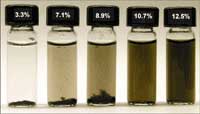| Posted: January 17, 2007 |
Environmental impact of carbon nanotubes |
|
(Nanowerk News) Carbon nanotubes (CNTs) are among the most widely manufactured and commercialized nanomaterials, but what happens to them in the environment? Environmental engineer William Ball and surface chemist Howard Fairbrother at Johns Hopkins recently received funding from the Institute for NanoBioTechnology (INBT) to investigate the fate and effects of CNTs in aquatic environments.
|
|
“The production and use of CNTs has skyrocketed as their commercial applications, including flat panel displays, biomedical imaging, and targeted drug delivery, grow,” says Ball. “But research on the health and environmental consequences of these engineered materials has unfortunately lagged behind commercial advancement.”
|
 |
| The vials contain similar concentrations of carbon nanotubes in water with different levels of oxidation, displayed as a percentage on the vial’s cap. (Image: Billy Smith/Johns Hopkins)
|
|
Concern about the potential impacts of CNTs and other nanoscale materials are being raised by environmental scientists because the roles of the materials’ chemical and physical properties on environmental fate and effect are not fully understood. Such properties are sometimes deliberately altered to enable manipulation or can be incidentally altered by natural environmental processes after the particles are released, says Ball. Thus, scientists do not yet know how these new materials interact with toxic contaminants and how they behave in and move through the natural environment.
|
|
Ball and Fairbrother began collaborating on the surface chemistry and environmental fate of black carbon a few years ago. Not long into their work together, the two started discussing CNTs. When INBT announced seed funding to jumpstart new projects at Hopkins focused on health and environmental issues of nanotechnology last fall, Ball and Fairbrother applied and received $25,000 to initiate a study and fund post-doctoral researcher Huyn-Hee Cho.
|
|
Their study is focused on the effects that surface oxidation and adsorbed natural organic matter exert on the properties of CNTs in aquatic environments.
|
|
“The surface chemistry of a carbon nanotube is particularly important in determining its stability in water,” says Fairbrother. “As oxygen-containing functional groups (e.g. hydroxyl, carbonyl, and carboxylic) are added to its surface, the carbon nanotube’s stability in aquatic environments increases. We expect the effects of surface oxidation to have profound implications for the fate, transport, and environmental impact of carbon nanotubes.”
|
|
The researchers are looking at how CNTs behave in water, to what extent they aggregate, and to what extent they harbor and interact with toxic contaminants. Lab experiments include functionalizing CNTs through surface oxidation and exposing the materials to natural organic matter to test adsorption. The effect of surface oxidation and natural organic matter on the sorption of pollutants is also being studied using new sorption methods for finely dispersed black carbon materials developed by Ball’s research group.
|
|
Ball is professor of environmental engineering at Johns Hopkins and faculty member of the following university centers and institutes: Institute for NanoBioTechnology; Center for Contaminant Transport, Fate and Remediation; Center for Hazardous Substances in Urban Environments; Center for Applied and Environmental Fluid Mechanics; and Center for Water and Health.
|
|
Fairbrother is associate professor of chemistry and materials science and engineering at Johns Hopkins and faculty member of the Institute for NanoBioTechnology and the Center for Hazardous Substances in Urban Environments.
|

